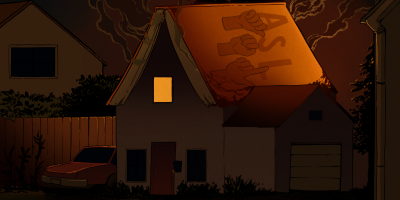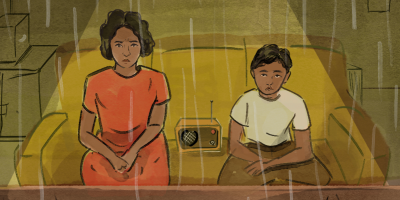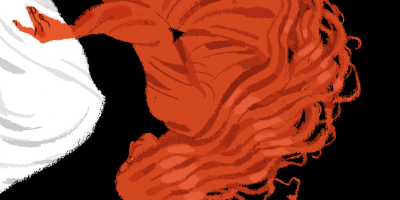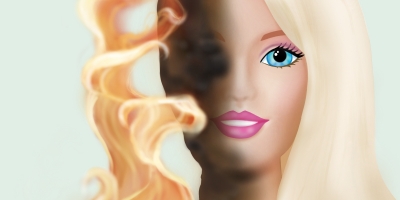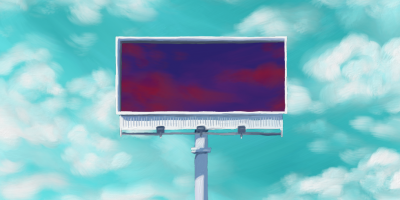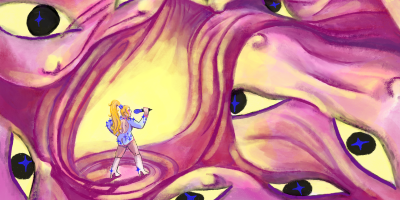Fiction
The Following
by Abigail Oswald

It’s hard to see her at first. The iPhone footage is shaky, as if filmed by an amateur wildlife photographer. The Pop Star comes into view across from the cash register, sobbing hysterically, begging the guy behind the phone to put it down. The video continues. She keeps swiping at her hair, trying to clear her vision, but her bangs just fall back into place. The audio is spotty at best, her words mostly incomprehensible. She wrings her hands. The cashier keeps shaking her head and finally begins to remove the Pop Star’s sad little tub of hummus and family-size bag of pita chips from the conveyor belt.
Here the camera shifts, and a blinding ray of sunlight passes through the window. For a split second the Pop Star is obliterated, then bathed in a lush gold. Her hair shines, her eyes burn, she goes very quiet. The cashier relaxes, thinking the episode is over. The Pop Star smiles, tears still streaming down her cheeks. Her teeth gleam.
In that moment, she vaults onto the counter separating her from the cashier, her platforms sliding for purchase as the belt moves, and sinks her long red nails into the girl’s bare neck. The Pop Star screams, like an animal in pain. There are no words to make out, as she’s no longer trying to communicate—just an unintelligible tunnel of agony that goes on and on, its register so high your speakers will likely be unable to reproduce the sound.
You can hear the guy behind the camera just fine, though. He’s laughing.
At the beginning, there are six of us. We find each other in the comments of the viral video, immediately recognizing the deeper knowledge that separates us from other fans, that makes us true purveyors of the Pop Star’s history. In the following days, we trade rare photo-shoot outtakes and scans of old magazine interviews like baseball cards. We compare notes on her breakups and her boyfriends. We could’ve lived our whole lives this way, separated by screens. Clicking, reading, responding. But after a few more weeks pass and there’s still no news, Stef wants more. It’s her idea to meet.
The barista asks if we’re a book club, and one of us snort-laughs. We order six overpriced lattes with the same golden sheen the Pop Star used to post, but ours come without foam hearts drifting on the surface. Two of us are wearing T-shirts featuring the Pop Star’s glittering face and airbrushed body. We all overapplied our makeup, nervous about meeting after our previous digital interactions had been so filtered. A spectrum of peach and red kisses graze the rims of our cups when we set them down.
There’s no attempt to veil the reason for our connection, so we quickly begin to speculate about the cause of the Pop Star’s breakdown. Six detectives piecing together the days preceding a crime. She is not mentally ill, we decide, though none of us have studied psychology.
We are nannies, waitresses, and an accountant, except Stef. Stef is not any of these. None of us has been able to ascertain what she does for a living. She is the one who suggests blaming the boyfriend, her blond hair swishing with each sentence, her nails blood red. An energy rolls off her that has nothing to do with caffeine.
It’s the ex-boyfriend, she repeats, and we find ourselves nodding, though most of us have other theories.
Look, we could talk about her all day.
We know where she was born, the names of her brother, sisters, cousins, bodyguards, and childhood pets.
Ask us to list all her songs in alphabetical order. Chronological.
We’ve heard all the secret singles and we know the B-sides.
We probably know more about her than her interviewers.
We certainly know more than you.
Not long after our meetup, the Pop Star is moved to an unnamed private rehab. Again we find out about this through various online and print media outlets. One of us comes across her face in the aisle at the grocery store. Though the tabloid had copious promotional images to choose from, they publish a ghastly still from the video, the moment after she’s climbed up on the counter but before she sinks her nails into the cashier’s neck. The Pop Star is gnashing her straight white teeth—not sad anymore, but at the instant of her shift into fury. It takes a moment to recognize her.
What was she so angry about? I wonder, staring at her frozen face. And why was she alone?
We share these new stills obsessively in the group chat, bemoaning the pixelated desecration of our idol. Her legs, though, some note, look the best they ever have. All the Pilates. So we sign up for classes—the ones who can afford it, anyway.
One of the nannies has been checking in less and less, claiming the moms have increased her hours. We create a second group chat to speculate about her waning interest, her lack of true devotion. She isn’t like us. She didn’t even know about the fired bodyguard.
She tries to start another conversation—our hobbies, our families. She is missing the point.
Stef starts riding the subway out to the Pop Star’s neighborhood, where she buys palm-sized chocolate bars and eats them slowly, watching the registers. Eventually the now-familiar cashier’s shift coincides with one of her visits, so Stef sends us a picture. We know most things about the cashier too, at this point—at least everything that’s available on the internet. In the group chat we conclude she seems disappointingly like any other person, her eyebrows overplucked.
There are five of us now, and Stef tells us she has figured out where the Pop Star’s ex lives. He was vacationing in Rome during the Pop Star’s breakdown and did not return to the city until the following week, which to us smacks of disloyalty—the very idea that he would take his time when the Pop Star was so distraught.
Stef promises to keep an eye on him, ascertain whether he has a new girl in his sights.
Later comes a blurry picture of the ex in profile, silhouetted against a muted sunset. His internet-famous Jack Russell terrier poses beside a fire hydrant, staring into the camera with reproachful, lit-up eyes.
No girlfriend, Stef laments in the caption. He’s boring.
The accountant decides this is too weird for her. I stay quiet. Now there are only four.
The video I’ve watched the most is not a music video.
It’s not the breakdown video either, though we combed it thoroughly for clues.
The others opt for music and drama, but this one is my favorite. A fan recorded it when the Pop Star didn’t know anyone was watching. Just ten seconds.
She’s at a playground with her daughter, and the girl is running into her arms. In all of the videos and pictures I’ve ever seen of the Pop Star, there has never been such a look of pure, unadulterated happiness.
Recently I’ve started to realize the video shouldn’t exist at all. Because the Pop Star thinks she’s alone with her daughter. This is the reason for the expression, the laughter, the joy.
But the Pop Star hasn’t been alone in years.
Stef has ascertained which rehab took the Pop Star—a monthlong research project that finally bore fruit.
Stef is gleeful. Ecstatic. She goes on and on in the chat—there are only three of us now that the other nanny has renounced us, just me and her and a waitress—and I’m trying to convince her it’s not a good idea, she shouldn’t go, and Stef says she’s only going to show up with flowers, it’s fine! She’ll be nice! She just needs to know what happened, nobody knows what happened, but Stef will find out, Stef has the right, after all it’s the final piece in the Pop Star’s puzzle, the only thing left we don’t have a name for, and when she finally discovers the truth then she’ll know everything there is to know about the Pop Star.
The waitress eggs her on, laughing, until she has to leave for Pilates anyway. And then it’s just me, alone in the group chat, trying to convince Stef to stay home.
Hours later my phone chimes, the soft glow of its screen either a beacon or a warning.
I press back into the pillows. My room is airless; the darkness weighs on me. Perhaps Stef met the Pop Star and finally learned all her secrets. Or perhaps she didn’t go at all. I could go back to sleep. I could ignore all of this until morning. But I can’t fight the feeling that I have a duty to the Pop Star, somehow. So I reach for my phone.
Stef sent a video directly to me, circumventing the group chat altogether. I gaze down at my phone uncertainly, its white light streaking out as if through an open door. And for the hundred thousandth time in my life, I press the Play button on that tiny screen.
The camera pans slowly across the grounds: an immaculate green lawn, a palatial central building. The entrance expands in my hand as Stef approaches, her breath ragged. It’s a clear and beautiful night, I realize, apropos of nothing. I think above the roof I might’ve seen a star.
“I’m here,” Stef whispers loudly. “I made it.”
I barely have time to process this information before I receive a video call. I pick up on the first ring, unsure in that instant whose face I expect to see.
Instead I am met with a shaking view of three pairs of feet. Stef’s hand is waving wildly; she’s shouting at someone.
“You can’t be here,” a deep voice says. “This is private property.”
“You don’t understand,” comes Stef’s response. “She owes us the truth.”
“We’ll let her know,” says a second voice. He’s laughing. I wonder if this has happened to them before. “We’ll have to escort you from the premises, miss. Please don’t resist—”
Then, grass. Trees. A flash of indigo sky. She’s broken free, she’s trying to run. I can hear the men yelling behind her, their voices more distant. Feet on pavement. Then her phone catapults into the bushes and my screen goes black.
I hear the clink of cuffs, labored breathing, Stef weeping incoherently. My fingers shaking, I end the call. I know there will not be another.
I think of the Pop Star, sleeping peacefully in her own bed as this scene unfolds below her, entirely unaware of Stef—of any of us. Her blond hair spilling across the pillow, its chestnut roots beginning to come in for the first time in years. Bright stars twinkling through the skylight. Nobody looking at her at all.
Why did we feel the need to know everything there was to know about the Pop Star? What could explain that compulsion to list her favorite breakfast foods, her go-to shades of lip gloss? What was it about her that made us want to scoop out every crevice of her life until she had nothing left that was only hers?
For me, it all began with the euphoric state of seeing her perform live for the very first time. The knowledge that she and I were in the same room, breathing the same air. That she was human and I was too, and in a way that meant we were the same. The perennial hope that she might gaze into the crowd and see me, validate with her gaze the fact of my very existence. That she might understand in that moment how much I loved her.
There’s a single story that surfaces online after the arrest, but Stef never makes the Pop Star’s Wikipedia page. The reporter spells her name wrong.
I saw the Pop Star today. I don’t have anyone left to tell.
She was just walking down the street, like any person would. Like I do. Holding her little girl’s hand. Less tan, less toned, but God, did she look happy.
When she passed by, I looked away.
